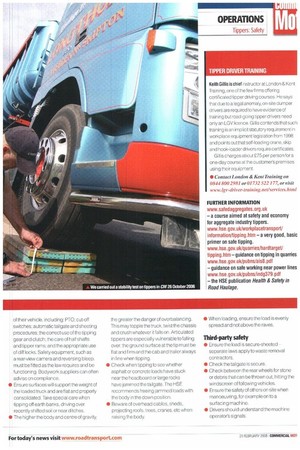KEY SAFETY AREAS
Page 38

Page 39

If you've noticed an error in this article please click here to report it so we can fix it.
Driver safety
• On site, especially in quarries, many companies have their own safety rules. HSE regulations and the Mines and Quarries Act may also apply.
• Take care when working at height, eg when climbing onto the body and unsheeting the load. Bodywork should have the appropriate steps, ladders and safety rails.
• When working on the vehicle with the body raised, props must be inserted before climbing between the body and chassis. The HSE prefers tipping mechanisms to operate from the cab.
• If a lorry topples when tipping, HSE advice is never to jump out; brace yourself in the cab away from windows.
• If a raised body strikes alive cable, the HSE advises never to make contact with the ground and the vehicle (or anything touching the vehicle) at the same time. This would complete an electrical circuit and may cause injury or death. Also make sure no one else comes into contact with the vehicle or anything touching it while it is still touching the power cable. Secure the surrounding area, call 999 and contact the local electricity supplier. of their vehicle, including: PTO; cut-off switches; automatic tailgate and sheeting procedures; the correct use of the tipping gear and clutch; the care of half shafts and tipper rams; and the appropriate use of diff locks. Safety equipment, such as a rear-view camera and reversing bleep, must be fitted as the law requires and be functioning. Bodywork suppliers can often advise on compliance.
• Ensure surfaces will support the weight of the loaded truck and are flat and properly consolidated. Take special care when tipping off earth banks, driving over recently shifted soil or near ditches.
• The higher the body and centre of gravity, the greater the danger of overbalancing. This may topple the truck, twist the chassis and crush whatever it falls on. Articulated tippers are especially vulnerable to falling over; the ground surface at the tip must be flat and firm and the cab and trailer always in line when tipping.
• Check when tipping to see whether asphalt or concrete loads have stuck near the headboard or large rocks have jammed the tailgate. Thel-ISE recommends freeing jammed loads with the body in the down position.
• Beware of overhead cables, sheds, projecting roofs, trees, cranes, etc when raising the body. • When loading, ensure the load is evenly spread and not above the raves.
Third-party safety
• Ln su re the load is secure-sheeted separate laws apply to waste removal contractors.
• Check the tailgate is secure.
• Check between the rear wheels for stone or debris that can be thrown out, hitting the windscreen of following vehicles.
• Ensure the safety of others on site when manoeuvring, for example on to a surfacing machine.
• Drivers should understand the machine operator's signals.












































































































































































